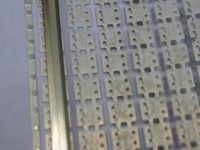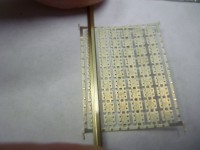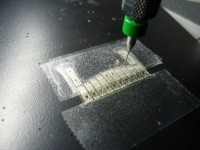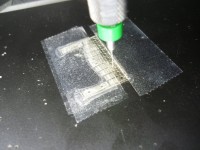.
Cosmetic Tie Plates
I received the Proto 87 Stores cosmetic tie plates this afternoon. I was hoping to use them with code 70 rail on the lighter weight sections of the layout. The feature that got me interested in them was the 4 holes for spiking and the absence of the simulated spike heads typically found with Proto87 Stores tie plates. I was disappointed they are too small for code 70 rail. The base of the code 70 rail extends over the spike holes. I did check a small piece of code 55 rail and they do work with that. (so maybe I’ll be going to code 55 🙂 Or maybe that’s just too far down the rabbit hole.
Turnout Tie Plates
On another related tie plate topic. I decide to drill out extra spike holes in some of the special turnout tie plates. I used a #76 bit in my Dremel Workstation and just did my best to line it up with the simulated spike head and drill right through it. It worked out pretty well. I can’t see doing thousands of these, but some key tie plates on the turnouts shouldn’t be a problem.
Wandering Track
Finally, regarding the section of track I spiked down earlier this week (see Sleight of Hand), I need to rip it out. I messed up and let it wander, which wouldn’t be a problem, but if it continues it’s current course will wander right off the homasote. So my first 12″ section will be redone, kind of a bummer, but I want it done right.
Considering a Code Change
I mentioned earlier a possible code change on my light weight track. My initial plan was to use code 83 on the heavy track and code 70 on the lighter track. I’m considering changing this paradigm to code 70 and code 55, which would be closer to prototype. My actual prototype uses heavy track that is about 6″ tall and lighter track that is about 4 3/4″ tall. Checking Andy’s Prototype and HO Model Rail Sizes reference page puts it solidly at code 70 and code 55. The only concern I have is outlay of cash.
Thanks for reading Greg
4,140




The Proto:87 Stores Cosmetic Tie plates are advertised as such, and thus designed to be, prototypically cosmetic (for scattering around track as shown) and thus match a close to a prototype rail size base width. They are not designed to fit any particular model rail. And prototypical rail generally has a narrower base compared to it’s height than does model rail. See http://www.proto87.com/page97.html for prototype drawings.
Proto:87 working tie plates are advertised as available to perfectly fit either code 70/83 model rail or separately, to perfectly fit code 55 model rail. Code 40 working tie plates may become available in the future. They also have central holes to allow for glue to pass all the way through them, and a gauge line to aid any scratch building alignment, both of which are hidden once model rail is laid on them. As well as dummy spike heads, they have many scale open spike holes for those who wish add working scale spikes for fixing the rail down in a scale manner to scale wood ties, and that is encouraged for extra strong fixing of rail ends at rail joints.
The Proto:87 Stores tie plates, spikes, rail, frogs, throw-bars, points and wood ties all are deliberately and specifically designed to be part of a system (Ultimate Track) of extremely accurate and realistic working parts, which are all guaranteed to work together as advertised to produce the advertised result. (Both in Proto:87 as well as Regular HO). And we provide heavily discounted turnout and track kits of complete sets of matching parts to save the modeller having to work out which parts are required for any particular track or turnout configuration. And free on-line support for questions and anyone needing help.
Of course it is not possible to offer parts that can be arbitrarily modified, wrongly substituted, or misfitted with disregard for the instructions, and still expect the correct results to occur. In case of doubt, our on-line support list, (ACCU-TRAK), can be used to ask questions about other uses that may be practical.
Hope this helps.
Andy Reichert
The Proto:87 Stores
I’m sorry to see you discovered the hard way like I did that those tie plates don’t work with code 70. I was a bit disappointed, especially as I had ordered rail with the rest of the order so it was pretty clear what I was using the tie plates with.
In the end I chose to use CV plastic tie strips for both plain track and turnouts, using Joe Fugate’s ideas for using the turnouts as a jig. I work in standard HO scale not P-87 because of the difficulty of rewheeling steam engines.
I enjoyed reading about your project, good site.
I think flange depth may not be a problem. The P:87 wheel flange is .012″ to .014″. I checked it out visually with a car on a small section of track and flanges cleared no problem. I’ll have to do a section of test track with spikes to test it more accurately.
The other thing to think about with Code 55 rail is you might have to change to a smaller flange. I’m not sure if this is as big of a deal with P:87 as it is with the regular standards. If it was me I’d lay a test track with 83 & 70, and then 70 & 55. See what you like after it’s weathered. I shifted from code 250 to 215 because of the visual difference. With 200+ of code 250 rail I’ll likely end up using it for storage tracks.